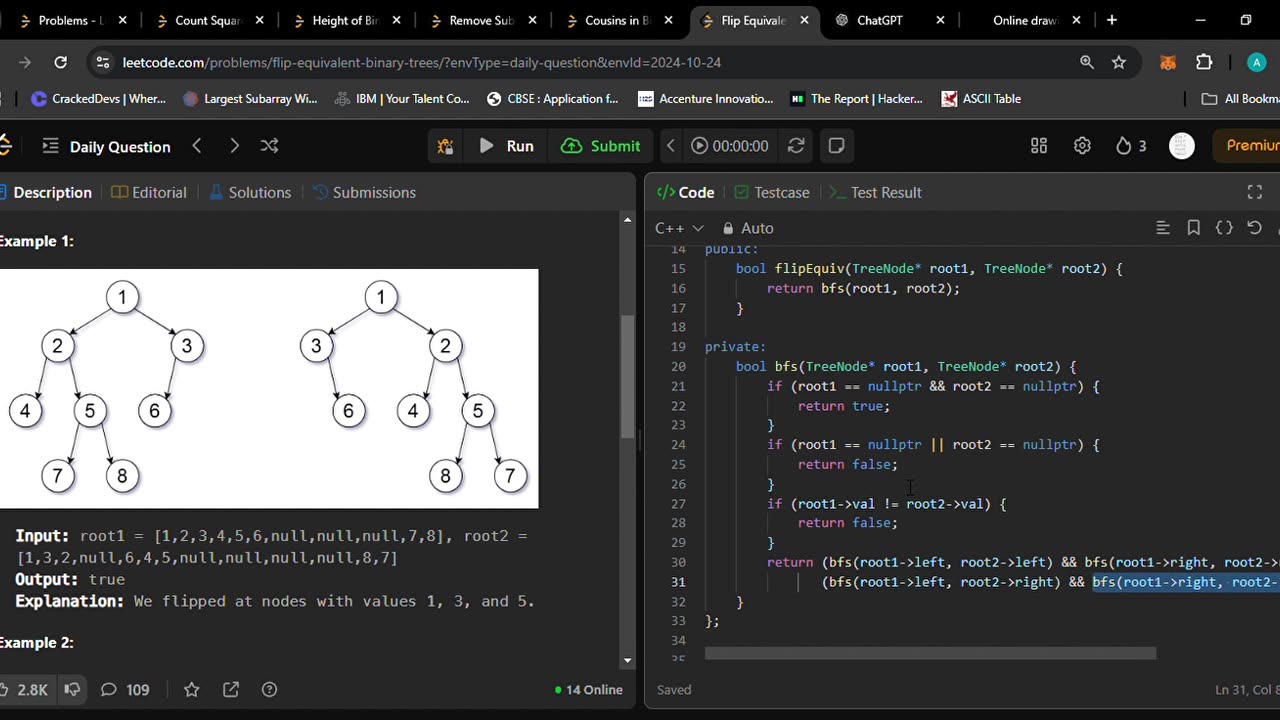Premium Only Content

951. Flip Equivalent Binary Trees
Code:-
/**
* Definition for a binary tree node.
* struct TreeNode {
* int val;
* TreeNode *left;
* TreeNode *right;
* TreeNode() : val(0), left(nullptr), right(nullptr) {}
* TreeNode(int x) : val(x), left(nullptr), right(nullptr) {}
* TreeNode(int x, TreeNode *left, TreeNode *right) : val(x), left(left), right(right) {}
* };
*/
class Solution {
public:
bool flipEquiv(TreeNode* root1, TreeNode* root2) {
return bfs(root1, root2);
}
private:
bool bfs(TreeNode* root1, TreeNode* root2) {
if (root1 == nullptr && root2 == nullptr) {
return true;
}
if (root1 == nullptr || root2 == nullptr) {
return false;
}
if (root1->val != root2->val) {
return false;
}
return (bfs(root1->left, root2->left) && bfs(root1->right, root2->right)) ||
(bfs(root1->left, root2->right) && bfs(root1->right, root2->left));
}
};
Question:-
For a binary tree T, we can define a flip operation as follows: choose any node, and swap the left and right child subtrees.
A binary tree X is flip equivalent to a binary tree Y if and only if we can make X equal to Y after some number of flip operations.
Given the roots of two binary trees root1 and root2, return true if the two trees are flip equivalent or false otherwise.
Example 1:
Flipped Trees Diagram
Input: root1 = [1,2,3,4,5,6,null,null,null,7,8], root2 = [1,3,2,null,6,4,5,null,null,null,null,8,7]
Output: true
Explanation: We flipped at nodes with values 1, 3, and 5.
Example 2:
Input: root1 = [], root2 = []
Output: true
Example 3:
Input: root1 = [], root2 = [1]
Output: false
Constraints:
The number of nodes in each tree is in the range [0, 100].
Each tree will have unique node values in the range [0, 99].
-
 3:10:08
3:10:08
TimcastIRL
5 hours agoNO KINGS Protester Yells KILL DHS, Liberal Tries KILLING Trump Supporter At His Home | Timcast IRL
92 -
 1:00:31
1:00:31
FreshandFit
8 hours agoWe Are In A Recession...Do This Now!
2.22K21 -
 LIVE
LIVE
Side Scrollers Podcast
1 day ago🔴SIDE SCROLLERS FUND-A-THON🔴DAY 1🔴100% REVENUE HELPS CHANGE CULTURE!
1,240 watching -
 3:03:39
3:03:39
Barry Cunningham
7 hours agoPRESIDENT TRUMP HAS A MAJOR WIN AND HIS TEAM IS ABSOLUTELY UNLEASHED!
67931 -
 58:59
58:59
Flyover Conservatives
1 day agoThe Agenda Behind No Kings — They Lied. They Funded It.; Silver Explosion FAR from Over, PhD Explains What’s Next and Why! - Dr. Kirk Elliott | FOC Show
4.53K4 -
 1:55:03
1:55:03
We Like Shooting
16 hours agoWe Like Shooting 633 (Gun Podcast)
106 -
 1:32:29
1:32:29
Glenn Greenwald
8 hours agoNo Kings Protests: A Partisan Pro-DNC Circus; The Trump Admin's Escalating Strikes on "Drug Boats" and Militarization of the Caribbean | SYSTEM UPDATE #534
17.4K72 -
 3:49:31
3:49:31
SOLTEKGG
5 hours ago🔴LIVE - BATTLEFIELD 6 W/ SOLTEK
-
 3:46:40
3:46:40
VapinGamers
5 hours agoBattlefield 6 - Gettin My Body Ready for BR and Other Funzies with Friends - !rumbot !music
-
 41:43
41:43
MattMorseTV
7 hours ago🔴It’s ACTUALLY HAPPENING…🔴
3.65K101